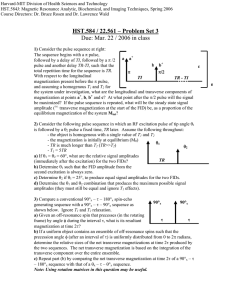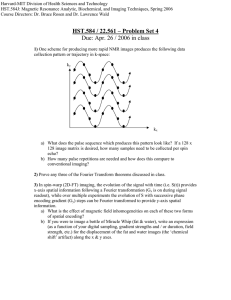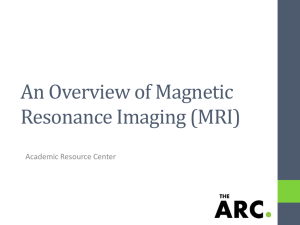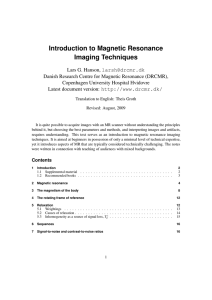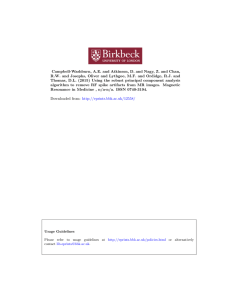HST.584 / 22.561J Quiz – Mar. 22 / 06
advertisement
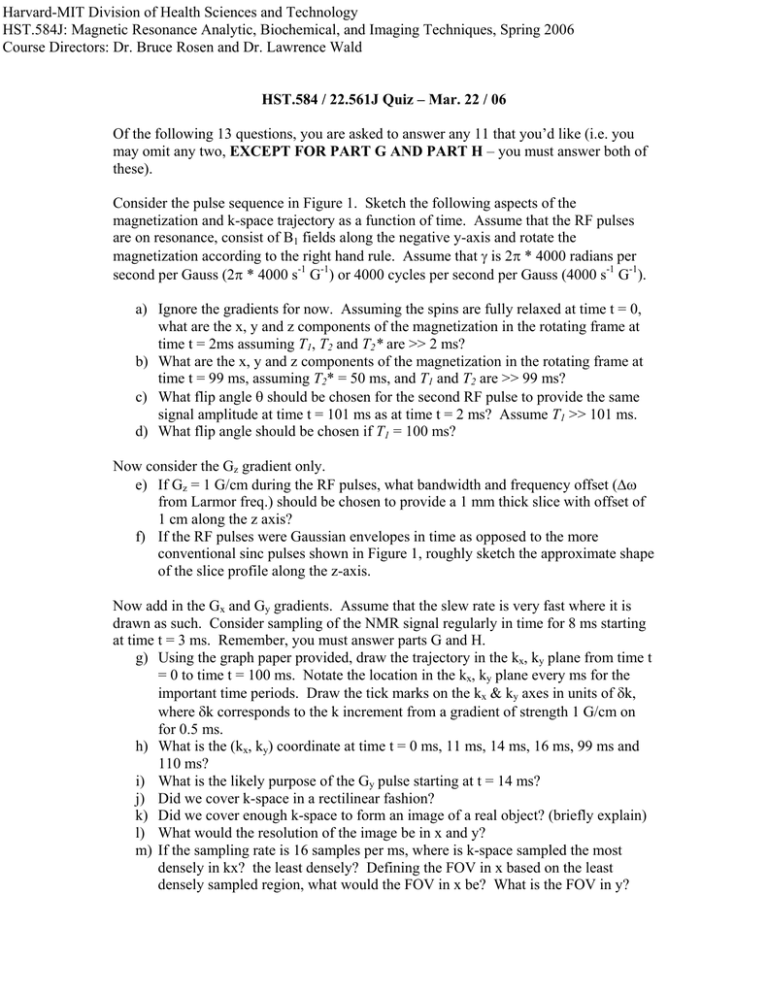
Harvard-MIT Division of Health Sciences and Technology HST.584J: Magnetic Resonance Analytic, Biochemical, and Imaging Techniques, Spring 2006 Course Directors: Dr. Bruce Rosen and Dr. Lawrence Wald HST.584 / 22.561J Quiz – Mar. 22 / 06 Of the following 13 questions, you are asked to answer any 11 that you’d like (i.e. you may omit any two, EXCEPT FOR PART G AND PART H – you must answer both of these). Consider the pulse sequence in Figure 1. Sketch the following aspects of the magnetization and k-space trajectory as a function of time. Assume that the RF pulses are on resonance, consist of B1 fields along the negative y-axis and rotate the magnetization according to the right hand rule. Assume that γ is 2π * 4000 radians per second per Gauss (2π * 4000 s-1 G-1) or 4000 cycles per second per Gauss (4000 s-1 G-1). a) Ignore the gradients for now. Assuming the spins are fully relaxed at time t = 0, what are the x, y and z components of the magnetization in the rotating frame at time t = 2ms assuming T1, T2 and T2* are >> 2 ms? b) What are the x, y and z components of the magnetization in the rotating frame at time t = 99 ms, assuming T2* = 50 ms, and T1 and T2 are >> 99 ms? c) What flip angle θ should be chosen for the second RF pulse to provide the same signal amplitude at time t = 101 ms as at time t = 2 ms? Assume T1 >> 101 ms. d) What flip angle should be chosen if T1 = 100 ms? Now consider the Gz gradient only. e) If Gz = 1 G/cm during the RF pulses, what bandwidth and frequency offset (∆ω from Larmor freq.) should be chosen to provide a 1 mm thick slice with offset of 1 cm along the z axis? f) If the RF pulses were Gaussian envelopes in time as opposed to the more conventional sinc pulses shown in Figure 1, roughly sketch the approximate shape of the slice profile along the z-axis. Now add in the Gx and Gy gradients. Assume that the slew rate is very fast where it is drawn as such. Consider sampling of the NMR signal regularly in time for 8 ms starting at time t = 3 ms. Remember, you must answer parts G and H. g) Using the graph paper provided, draw the trajectory in the kx, ky plane from time t = 0 to time t = 100 ms. Notate the location in the kx, ky plane every ms for the important time periods. Draw the tick marks on the kx & ky axes in units of δk, where δk corresponds to the k increment from a gradient of strength 1 G/cm on for 0.5 ms. h) What is the (kx, ky) coordinate at time t = 0 ms, 11 ms, 14 ms, 16 ms, 99 ms and 110 ms? i) What is the likely purpose of the Gy pulse starting at t = 14 ms? j) Did we cover k-space in a rectilinear fashion? k) Did we cover enough k-space to form an image of a real object? (briefly explain) l) What would the resolution of the image be in x and y? m) If the sampling rate is 16 samples per ms, where is k-space sampled the most densely in kx? the least densely? Defining the FOV in x based on the least densely sampled region, what would the FOV in x be? What is the FOV in y?




